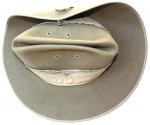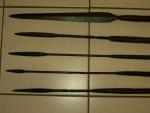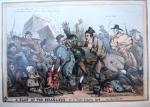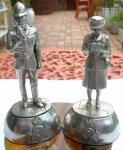-
Posts
13,225 -
Joined
-
Last visited
-
Days Won
22
Content Type
Profiles
Forums
Blogs
Gallery
Events
Store
Everything posted by Mervyn Mitton
-

CAVALRY SWORD - PORT. OR, ITALIAN ?
Mervyn Mitton replied to Mervyn Mitton's topic in Swords & Edged Weapons
-

CAVALRY SWORD - PORT. OR, ITALIAN ?
Mervyn Mitton replied to Mervyn Mitton's topic in Swords & Edged Weapons
-
This is one for the sword collectors to 'get their teeth into' . I can recognise it as European - the name looks Italian - also, looks Portuguese in style. Since we had two of their colonies either side of Sth. Africa, I tend to favour this idea, but, what date and was it for Colonial Forces or, brought from Europe ? Over to you....
-
I thought perhaps, we could continue this thread on the Aust. Rising sun badge, by also including a history of our famous slouch hats ? My first mil. service was with National Service when I was 18. I was put into the Sydney 17th. LAA (Light Anti Aircraft)Regt. and we were trained on 40mm. Bofors - I still think it was a marvellous weapon - and so versatile. When I returned in 1960 from Sth. Africa, I was in Brisbane and joined the Queensland Regt. - this hat and badge was my issue. Unfortunately, I was 'headhunted' to go to Thailand and never returned to Aust. to live. I am very open to correction on this - but, I don't think the slouch hat origins are Australian? The Sth. African miners and on the farms, had been using this style for many years and when the Boer War broke out in 1899, most of the irregular colonial forces were outfitted with the pattern. A wonderful hat to protect the head from strong sun - when opened it gives exceptional protection from rain. I have shown the clip fitted to mine - however, some use a press stud. The puggaree is the standard fold and colour for the Aust. Infantry - or, it was at that time. When we were issued with the hat we had to put our own 'bash' in the top - this is done by soaking the top and then hitting it sharply with the side of the hand. We used clothes pegs to hold it in position and after drying it always stays in. We had to get the 'bash' just right or your Sgt. Maj. could get very unpleasant. I suppose New Zealanders and the Canadian Mounties have the same problems. Although I wouldn't be surprised to find they come now with creases pre-done... I always wanted one of the NSW Mounted Police hats - they are in blue - if you ever hear of one for sale, please remember me....
-
This group photo shows the difference in sizes of various spears. I will be posting these spears individually, but the comparison shows just how deadly the Iklwa - or stabbing spear , was. The Iklwas is on the top, an Isiphapha, or throwing spear is underneath and the others are hunting types. Second from bottom is a small headed one for birds or, small game.
-
Brian - if it is 'print' related - then this could be a good thread, that hopefully we can develop. I will be adding a few more prints and the very rare tipstaff I mentioned. However, if you have a new item why not start another thread and , hopefully, we can add to that. I must tell you that after your vague outline - we are now all waiting with 'bated breath' (I wonder what a 'bate' was ? Would be a good 'odd expression' for the Lounge ?) Ian, I was very tired when I answered your note last evening - why not put a few details on this thread? I'm sure it would be of interest.
-

16th Bengal Cavalry Officer's Scroll Hilt
Mervyn Mitton replied to Jonathan Hopkins's topic in Swords & Edged Weapons
Hope you're still busy cleaning ? A point on your sword - I notice it has the 'By Appointment to the Prince of Wales ' - I thought they had the 'To the Queen' appointment - any idea of change over date ? I'm going to post a foreign cavalry sword tomorrow - we should try to keep this forum active. Doesn't compare to the Bengal sword, but it will be interesting to see what members think of it's origins. -
The earlier ones were not so elongated in the head - they were in fact similar to the hunting spears. Iron occures naturally in Natal - in fact one of the mountains where fighting took place in 1879, was Hlobane (shlobarn) - this was where Sir Evelyn Wood V.C. took a force to punish the local tribe and found himself cut-off by 20,000 advancing warriors. He retreated back to his camp at Kambula and the following day defeated the Zulus - our first success. However, I was going to say that Hlobane is over 5 kms. long and is of the finest iron ore. I'm told that it could supply the World for 20 years - which is why the Far Eastern countries - particularly China - are trying to get a hold on Africa. The spear head is beaten with a tang and this is inserted into the top of the shaft through a small bored hole. The top of the shaft is then bound to make a very firm join. There are three ways of binding - the cheapest was to use the centre stalk from an Ilala palm leaf, this would be woven with a depth of up to 8 inches from the top. Over years this also sets very hard, but it does fray and is then renewed. The most common is a section from the tail of a cow - pulled on whole like a condom. Again this sets very hard. Later, when the Zulus had made contact with the Portuguese in Delgoa bay, they established trade - ivory and skins for manufactured items, like brass and copper wire. I think it must have been on rolls like our old picture wire. Once woven into a decorative design they would take a heavy stone and beat it flat. With a plentiful supply of iron ore the guild of Zulu smithys found that they could use a green stone from the riverbeds to act as both a hammer and an anvil. This is a form of green dolomite - or, residual volcanic stone - very hard. There has been some interesting correspondence recently on the power the Sangomas (witchdoctors) exerted on the warriors before they went into battle. Modern thought is that Dagga (marijuana) was used to make them feel invincible against bullets....
-
King Shaka - 1816-24 - the first Zulu King, is credited with inventing this type of spear - and in doing so, changed the way battles were fought between African tribes. Until that point the shield was carried in the left hand, and the spear in the right. They also used battle axes and knobkerries. However, until Shaka , the right arm was raised in the air to strike downwards. This exposed the whole of the right side of the body - but, whilst every body else fought in this way , it wasn't important. Shaka changed this by having the Iklwa - still in the right hand - but used in a short forward stabbing action. The blade only needed to go in 3 or 4 inches ( 7.5cm - 10cm.) to cause death. This changed the face of warfare in Africa and made the Zulus the pre-dominent tribe. The length of an Iklwa could depend on the whims of the owner - some were very short and others up to 5 feet (150cm) - this good example ia approx. 3.5 feet overall (105cm) and the blade section is 17 inches (42cm). I show in an earlier post on this sub-forum, how the Zulu smithy's forged iron - you can see on this blade how it was beaten out to either side and just above the binding are the two pincer marks where it was held. The binding is cut from a cow's tail and pulled over whilst wet. After a while it sets like iron. The shaft is a local wood and flare at the end - this gives a grip to pull it from a body with bloody hands ! Shaka set very strict rules and the hands of his warriors were examined after a battle to make sure they had blood on them - failure in this could cost their lives. We all have our own opinions and for myself I don't think Shaka just came-up with the idea. The Roman gladius allowed their army to fight in just this way - and made them the pre-dominent military force for hundreds of years - until the tribes they fought learnt not to raise their right arms. The first European contact that Shaka is supposed to have had was with the British - however, the Portuguese had a colony in what is now Maputo (Mocambique) and I feel a Missionary probably made the trip to see Shaka and told him about the Romans. I don't suppose we will ever know - but it seems plausible. I will continue the other Zulu thread on their artefacts - but, will add further spears and weapons to this one. I hope it is of interest ?
-
The Metropolitan Police were the first civilian police force in the World - marching out from New Scotland Yard in June 1829. However, from when the word first spread that the Government planned a full police force, there was enormous opposition. People had been frightened by the French Revolution and had feelings that an organised body of men would be an armed force for the Govt. to use. This was why early uniforms were based on civilian dress. I have a number of hand coloured engravings from 1829 and will add them to make a thread - please add your comments and any other prints. This print was published in May 1829 and shows the three main instigators of the Police Bill. In the centre - punching the old 'charlie' - or, nightwatchman - is Sir Robert Peel - the Home Secretary. Behind him is the Prime Minister - The Duke of Wellington and behind him - carrying an umbrella - is The Lord Chancellor - 1st.Baron of England , Lord Lyndhurst. His real name - not his title - was Lord Gardiner. These three were directly responsible for our modern Police and are all important people. I own Lord Gardiner's silver tipstaff and will add it to the thread. The group of men whom they are 'fighting' are the night watch - or, as they were always known 'Charlies'. This was after King Charles 2nd. who established the Watch in 1661. They were elderly men - quite useless. Note that they have several candle lanterns showing, plus, many of the old alarm rattles - and the man Peel is punching has a cross belt for a sword. This is an important print and whilst I am sure that there are other examples, I haven't seen them. ( I have to be careful when I say things like that - someone - usually a friend in Washington - will immediately find 6 other examples ! )
-

16th Bengal Cavalry Officer's Scroll Hilt
Mervyn Mitton replied to Jonathan Hopkins's topic in Swords & Edged Weapons
Jonathan - you are to be congratulated. A rare sword and incredible research and detail. Really what collecting is all about. I look forward to seeing the 'after' pictures. How do you go about cleaning off all the marks and pitting ? I found the best way - but not touching the blade - was to have our silversmith use a very light buffing machine. All the marks come off the scabbaard and guard and the original metal finish is restored - but, it needs an expert with a 'light hand'. You comment on the competition for Indian associated swords - I think that applies to any old Indo/British pieces - big collecting field. Look forward to seeing more on this. Mervyn -
I've been having a closer look at the Kris examples Brian and Hugh have posted. Only when you examine all the surfaces do you realise the work and the quality. I think Brian's is very good - as you point out, the thinness of the blade is remarkable. I am no expert on metal but, I think there is a possibility that the blade was damascened (I couldn't think of this earlier) Many Kris' are worked with this folding of the metal - a long and arduous job - hopefully someone with more knowledge can advise ? Hugh's larger one - with the mystic background, also looks to have excellent workmanship. I don't think you were ripped off - the possibility has to be that it is an old one. I wish we had someone with more experience in this field. The cover for the sheath may be pressed, but the handle and blade look to be of good quality. The little sash one is well carved on the grip - ivory or, bone ? What do you think Hugh ? However, the sheath is all from one piece of wood - like my example - indicative of the importance of a kris. The religious aspect must also, not be overlooked. I saw a tv programme about the making of a special kris. Every aspect involved prayers and blessings and it took him about 8 months to make. If I remember correctly it had the astronomical value of about $100,000. Let's see what else we can find out - anyone else with a kris to show ?
-
Hi - Ed. I typed in Google - Austrian Police Uniforms and found a lot of sites. Several were from Austrian Police, so, this could be a good starter. There were a lot of posts from US police officers - I wonder why we can't attract them to our forum? Hope other members can give you better leads - look forward to seeing the hat? Are you on holiday ?
-
Hi Ian. Yes, I think this is a good example and unusual in this format. I particularly like the mis-spelling and the wrong designation, just so typical of the period. We have - another - public holiday tomorrow, so will try to remember to phone to say hello to you and Ann. Hugh, from when I first discovered what they were, they have held a great attraction. I think that it is more what they represented , then even their lovely shapes and workmanship. The tipstaff was essential for the official to perform his duties and therefore, represents the history of law and order in Great Britain for very many centuries. The fact that we could only find evidence of around 2000 remaining, is a tregedy - because it means so many have been lost or, destroyed. When I hold this one, for example, it is more than a highly valuable item - who was B. Evans - what did he actually do - what drastic situations did he face - who were his family, are there still descendents ? Research could possibly turn-up some answers - but, my collection at it's peak numbered over 800 heraldically painted truncheons (and thet was in part 1 of the collection) and over 340 tipstaffs. There were also, old uniforms,helmets,badges,medals,restraints,lighting etc.. To research it all was beyond me - especially with a business to run. Now that I have sold - and am selling - the collection, I can only hope that the buyers will continue to research. Unlike swords, pistols and uniform for the Army or, Navy - which were often made in tens of thousands - old police historical pieces are often their only examples. Being named makes a difference to value - I would sell this for around £1250 ($2000), however, it is potentially worth very much more - there isn't another one.
-
George 3rd. (he died 1820) or George 4th. (1820-1830) all brass tipstaff. Usually they had wood as a grip or, handle - so, fairly rare. The inscription is B.EVANS CONSTABLE OF SURREY. More correctly this should read 'A Constable of Surrey' - and the spelling of Surrey as Surry is not a mistake - rather the phoenetic spelling of the time. He would have been a High Constable in a biggish town, such as Guildford.The heralic Royal arms are the 1816 to 1835 pattern and show the Hanoverian Arms in the centre , with the Crown from when they became a Kingdom in 1816.
-
Not in the same league as the previous models - these are still police collectables. The rabbit P.C. is obviously based on Peter Rabbit from Beatrix Potter - made by Royal Doulton in the 1990's, it will be a valuable piece in year's to come. (this one and the next two, I showed on Lounge - but, they really belong here).
-
Another pair in the Stadden series. Very nicely cast in white metal - but, obviously not painted like the presentation ones. These models are good to have in a collection as they are accurate and show details of uniforms and equipment from the 1980's. PC and a London Traffic Warden. This is the hat Leigh referred to when talking WPC's pre-bowler pattern.



















